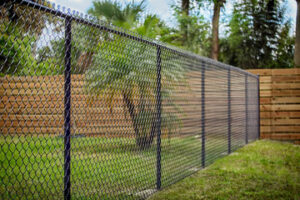Chain Link Fence Benefits and Disadvantages
Chain link fence is often used in high-security applications like airports and military bases. They are also commonly used in roadside highway projects and for securing correctional facilities.
 Start by marking the exact location of the corner, gate, and end posts with spray paint or a movable marker. Then measure the length between these posts to calculate how much chain link fencing you need.
Start by marking the exact location of the corner, gate, and end posts with spray paint or a movable marker. Then measure the length between these posts to calculate how much chain link fencing you need.
Cost
If you’re planning on installing a chain link fence, you’ll need to know how much it will cost. The cost depends on a number of factors, including height and gauge, linear footage, posts, gates, and additional accessories. You’ll also need to factor in landscaping or land clearing costs, if necessary. These services can add up to $10 per square foot, and may be a necessity if there are existing trees, shrubs, or stumps that need to be removed.
The framework of a chain-link fence is made from steel tubing that acts as posts. These are anchored into the ground, and connected with concrete to prevent them from shifting or pulling away. The steel mesh fabric, or weave, is then hung on top of the framework. The most common chain-link weave is plain galvanized steel, but you can also choose aluminum or vinyl-coated wire for a more durable and attractive finish.
Once you’ve chosen the height and gauge of your fence, calculate the number of linear feet to determine how much mesh you need. You’ll also need to determine how many line posts you need – usually every eight to 10 feet. You can install metal or wood posts, and these will influence the overall cost.
You’ll then need to consider any add-ons that you want, like gate hardware and post caps. Then, find the cost of your top rails in your preferred finish and add that to your total.
You may also need to purchase a permit, depending on where you live. This can add $20 to $400 to your project’s final cost. You can save money by installing the fence yourself, but you’ll need to have a lot of experience and the right tools to do it correctly. You’ll need to use specialist equipment like augers and fence stretchers, as well as mix cement and wrestle with heavy and unwieldy fence rolls.
Durability
Chain link fences are an effective security solution for industrial, commercial and residential properties. They are durable and can be made in a wide variety of heights, sizes and grades. They can also be adorned with accessories to add more security and privacy. Compared to other fencing materials, chain link fences are relatively inexpensive.
The main components of a chain link fence are a wire mesh, posts and rails. The metal wire in a chain link fence is galvanized to prevent corrosion and to withstand wear and tear. The fence fabric is often woven by hand to create the final design. The woven material is then coated with vinyl to protect it from the elements.
A chain link fence can be used to separate a property, limit access, or restrict traffic for a specified period of time. These fences are durable and are easy to install. However, they are not ideal for preventing burglary or other crimes. In addition, the galvanized steel can cause an allergic reaction in some people.
Typically, chain-link fences are constructed with a galvanized or vinyl-coated metal. The steel is woven into a fence, and then coated with either zinc or vinyl. It’s important to choose the right coating to protect the fence from weathering and corrosion.
The most common gauges for a chain-link fence are 9 and 11A 1/2. A higher gauge number means thinner metal, and a lower one is thicker. A 9-gauge fence is more suitable for residential use, while a higher-gauge fence is better for business and prison applications. Once you’ve chosen the best gauge for your needs, measure your proposed fence to determine how many feet of chain link and top rail are needed. Next, mark the position of each terminal post (corner, end and gate posts) with a stake.
Maintenance
If you have a chain link fence on your property, it is essential to maintain it properly. This will help you get the maximum lifespan from your fencing. Proper maintenance includes a regular cleaning to eliminate rust and a re-application of the rust-resistant coating. Keeping your fence in good shape will also reduce the risk of structural problems such as sagging and loose gates.
It is recommended to walk the perimeter of your fence every month. This will allow you to check for signs of rust, and address them immediately to prevent a larger problem. Additionally, you should look for any loose bolts or nails that need to be tightened. Loose bolts can cause the fence to become uneven and can cause parts of the fence to fall.
To keep your fence looking its best, wash it regularly with soap and water. In addition, you should wax your fence to protect it from moisture. It is important to use a metal-specific wax. In addition to this, you should also apply oil to the springs, latches, and joints on your fence.
Avoid growing vines or flowers on your chain link fence. These plants can damage the fence and impede its structural integrity. They can bend the support posts and weaken entire lengths of the fencing. In addition, children and pets may try to climb the fence, and this can result in bending and even breakage of panels. To prevent this, you can install vinyl slats or remove climbing aids such as logs and cinder blocks.
A well-maintained chain link fence will last for 15 years. However, this lifespan can be shortened by a variety of factors, including rust and improper installation. If you notice that your fence is starting to sag, it is a good idea to call a professional to perform a thorough inspection of the whole structure.
Privacy
Chain link fences are a popular way to enclose yards and property and they offer many benefits. They’re inexpensive compared to other fencing options, provide good security, and they can be easily customized to your needs. They’re also a great choice for sports fields, tennis courts, and residential properties. However, one of their biggest drawbacks is their visibility. Unlike other fencing materials, chain-link fences are 100% see-through.
Luckily, there are a few ways to add privacy to a chain-link fence. One option is to buy plastic slats designed for use with chain-link fences. These slats are available in a variety of colors and can be weaved through the chain-link fence to create a privacy barrier. You can find them online or at some home improvement stores. The slats are available in 4-ft and 6-ft heights, and they are suitable for both 9-gauge and 11-gauge chain-link fences.
Another option is to use fence tape. This product looks like a roll of fake pine needles and can be installed on a chain-link fence. It’s less expensive than a privacy slat, but it can be more time-consuming to install. It’s recommended to purchase a roll that covers 40 square feet, which means you’ll need about 1.5 rolls to cover a 10-foot long section of a 6-ft tall fence.
Finally, you can try to camouflage your chain-link fence with natural vegetation. Growing vines like ivy on your fence is a great option, but it may take a while to get the vines to grow to a height that will be comfortable. If you’re short on time, you can use fake vines that are made of plastic instead of growing plants. These are easy to attach to the fence and come in a variety of colors, including dark brown, gray, redwood tone, tan, and white.
Security
Chain link fences provide basic security to keep animals, children, and other people within a property. They can also be a deterrent to criminals by making them think twice before breaking into the property. There are several ways to make your chain link fence more secure, including adding slats or installing barbed wire on top of it. In addition, using galvanized steel rather than aluminum fittings is a good way to beef up security since they can’t be tampered with easily.
Adding slat inserts to your chain link fence adds privacy and visual barrier to your home or business. They are also easy to install and can be inserted into existing chain link fences. Some manufacturers even offer color coatings to match your home or office.
In addition to slats, you can also improve your chain link fence’s security by adding a bottom rail or by burying the chain link fabric underground. Burying the fabric 12 feet or more eliminates the possibility of crawling under a fence. Similarly, adding barbed tape to the top of your fence will also significantly delay forced entry, giving you time to take further action.
High security chain-link fences are designed to be virtually impenetrable. They typically feature small mesh openings – 3/8, 5/8 or 1 inch – and are made from 11 gauge aluminized steel wire with hot-dip zinc or polymer coating. They can be used in prisons, industrial factories and other high-security applications. Often, they are combined with razor wire for added security. This type of fence can be very expensive, but it provides a high level of protection for the assets inside. It can also help to protect vital infrastructure, such as natural gas and petroleum pipelines.
